Why companies are rethinking performance right now
Performance management has come a long way from the once-a-year review and vague development goals. Many teams are moving away from rigid processes and starting to ask a more useful question: how can we help employees grow while still hitting goals as a company?
For most, that means ditching the annual review in favor of more frequent check-ins, lightweight feedback, and goal tracking that actually supports day-to-day work. Managers want tools that make performance conversations easier, not more complicated. And HR wants visibility without needing to chase people for updates.
Whether you’re trying to improve manager–employee conversations or clarify your team’s goals, the right tools can help. This guide explores what to look for and which platforms are best positioned to support those goals in 2025.
What to look for in a modern performance management platform
The right tool depends on your team, your culture, and what you’re solving for. That said, there are a few core things that matter for most teams:
Flexible, manager-friendly reviews
- Templates should be simple to customize, easy to launch, and not require a PhD to interpret. The best tools help managers spend more time coaching, less time formatting.
Objectives that align people and priorities
- Whether you’re using OKRs or something more lightweight, goals should be visible, measurable, and connected to the conversations you’re already having.
Built-in feedback tools
- Praise, peer feedback, and structured 1:1 Meetings should happen where your team already works. Tools that support real-time feedback make it easier to build a culture of recognition and trust.
Useful reporting (not just more dashboards)
- Insightful data can help you spot gaps, recognize trends, and guide better decisions. But more data isn’t always better. Look for tools that surface what matters most, in a way that’s actually helpful.
How to choose based on your team’s size and stage
- Small teams (under 100): Prioritize ease of use. You’ll get the most value from tools that support flexible reviews, feedback, and objectives without requiring a dedicated admin.
- Scaling orgs (100–500): Look for structure without bloat. Tools that grow with you by offering automation, templates, and reporting will save you time and effort.
- Larger companies (500+): Flexibility and analytics matter. You’ll need custom workflows, integrations, and calibration tools that work across departments and locations.
10 Performance Management Tools Worth Exploring in 2025
1. Small Improvements
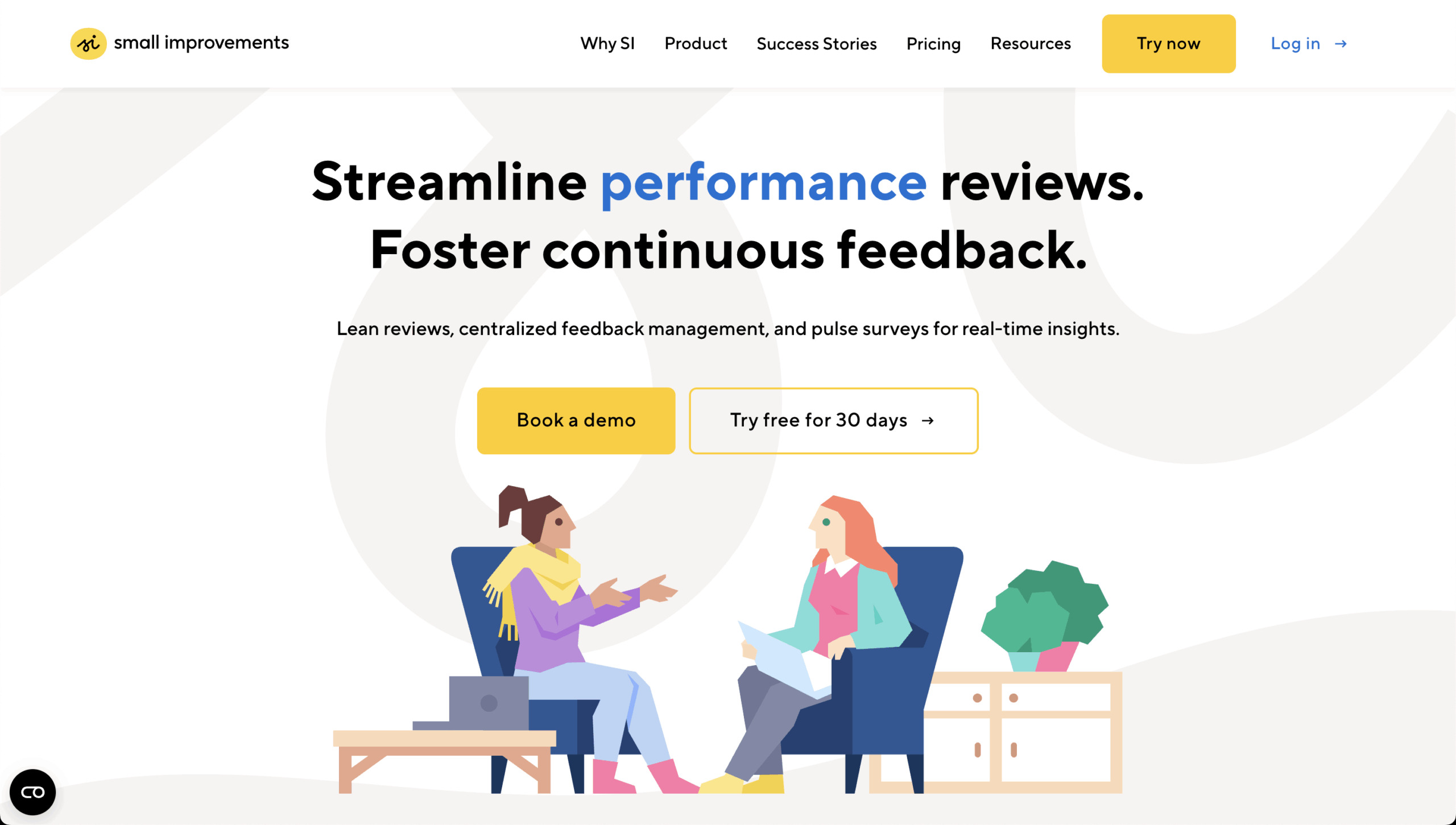
Best for: Small and midsize teams that want flexible reviews, feedback, and objectives without the enterprise bloat.
Small Improvements helps teams run reviews, 360s, 1:1 Meetings, and track objectives without slowing anyone down. It’s designed to support real conversations, not force a process. Managers get just enough structure to coach effectively, and HR gains visibility without adding friction.
Pros:
- Lightweight reviews and 360s with flexible templates
- Continuous feedback and shared 1-on-1 agendas
- Simple objectives tracking that doesn’t require full OKRs
Cons:
- Not built for advanced OKR mapping
- Analytics are lighter than enterprise tools
Pricing: Starting at $3 per user per month. 30-day free trial. No seat minimum. No implementation fees.
2. BambooHR
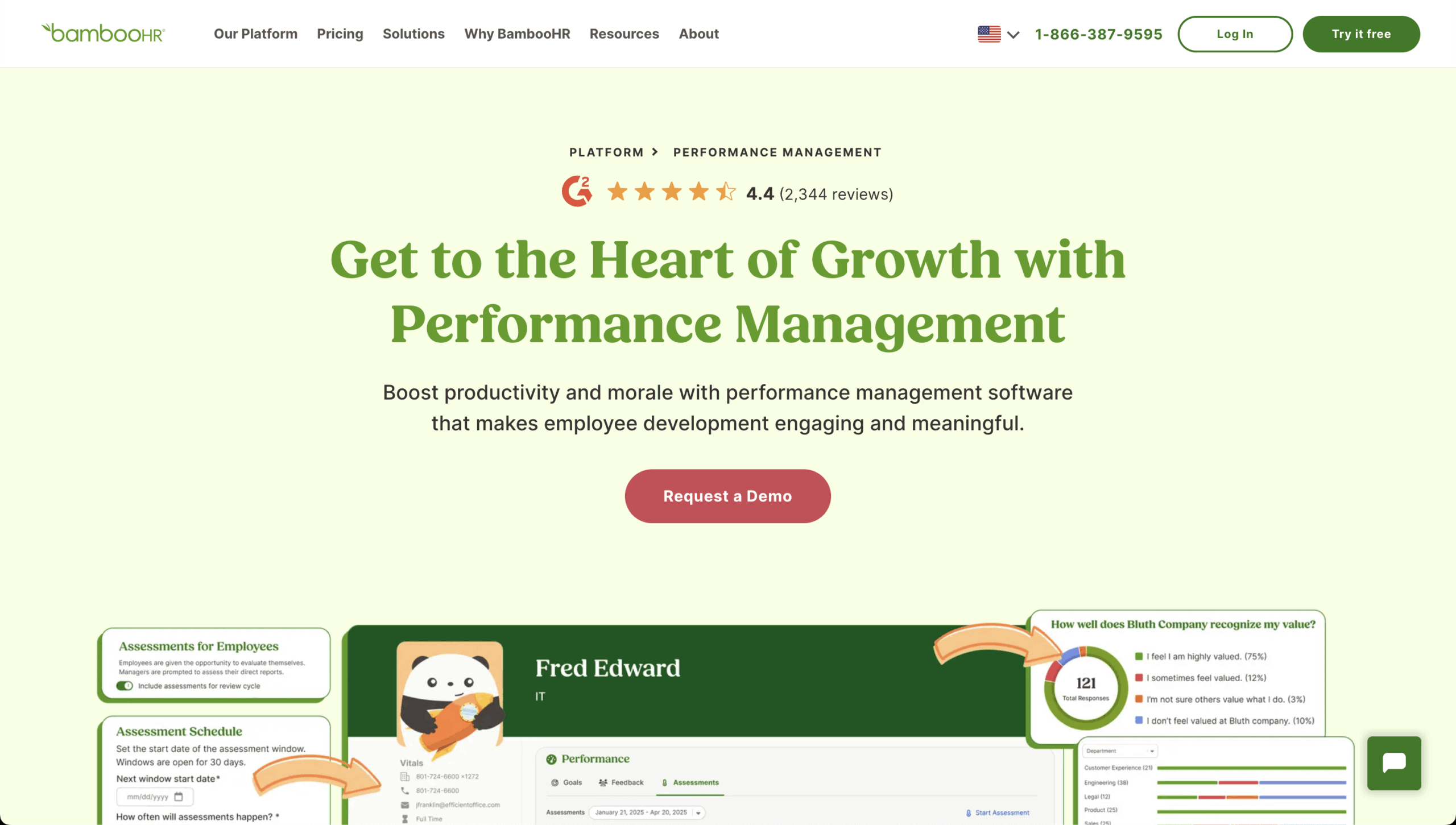
Best for: Small businesses that want light performance tools built into an all-in-one HRIS platform.
BambooHR offers basic performance features like self-assessments and goal tracking alongside its core HR tools. It is great for teams just starting with structured feedback.=
Pros:
- Simple, clean interface with integrations with other HR tools (p.s. – we’re one of them : ) )
Cons:
- No OKRs, light customization offerings and no advanced analytics
Pricing: Pricing on request. No free trial.
3. Leapsome
Best for: Scaling companies that want performance, engagement, and learning in one platform.
Leapsome connects reviews, OKRs, engagement surveys, and learning paths into a single workflow. Its visual goal dashboards and competency-based learning tools are handy for orgs investing in training and development.
Pros:
- 360 feedback, OKRs, and learning paths
Cons:
- Steeper learning curve for admins
Pricing: From $8 per user per month. Free trial on request.
4. Culture Amp
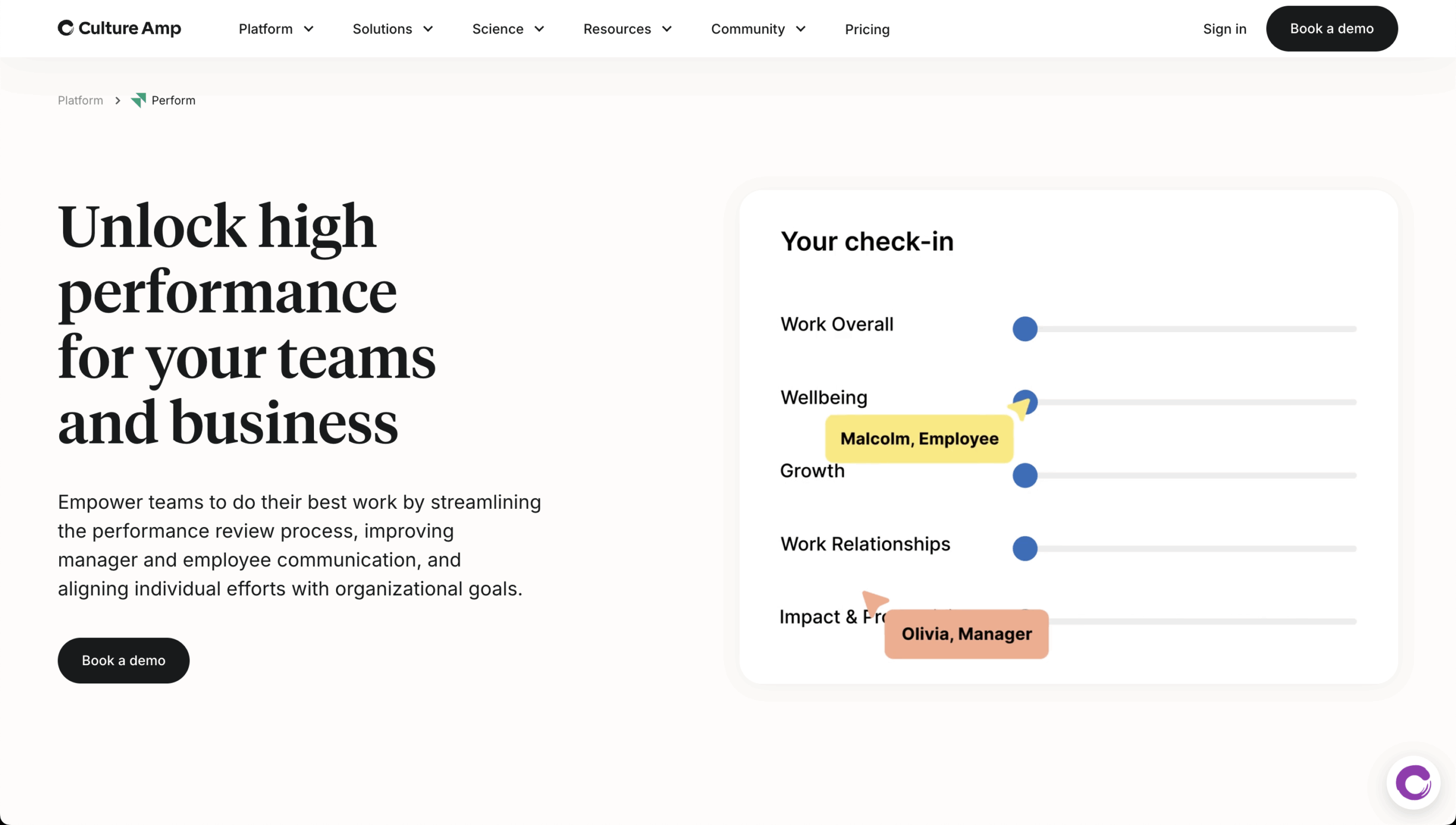
Best for: People teams prioritizing engagement and feedback backed by behavioral science.
Initially known for its engagement surveys, Culture Amp now includes continuous performance features. Its biggest strengths are its survey library, heatmaps, and science-backed insights.
Pros:
- Science-backed surveys, 360 feedback, Skills Coach
Cons:
- Limited integrations, performance tools are newer
Pricing: Pricing on request. No free trial.
5. HiBob
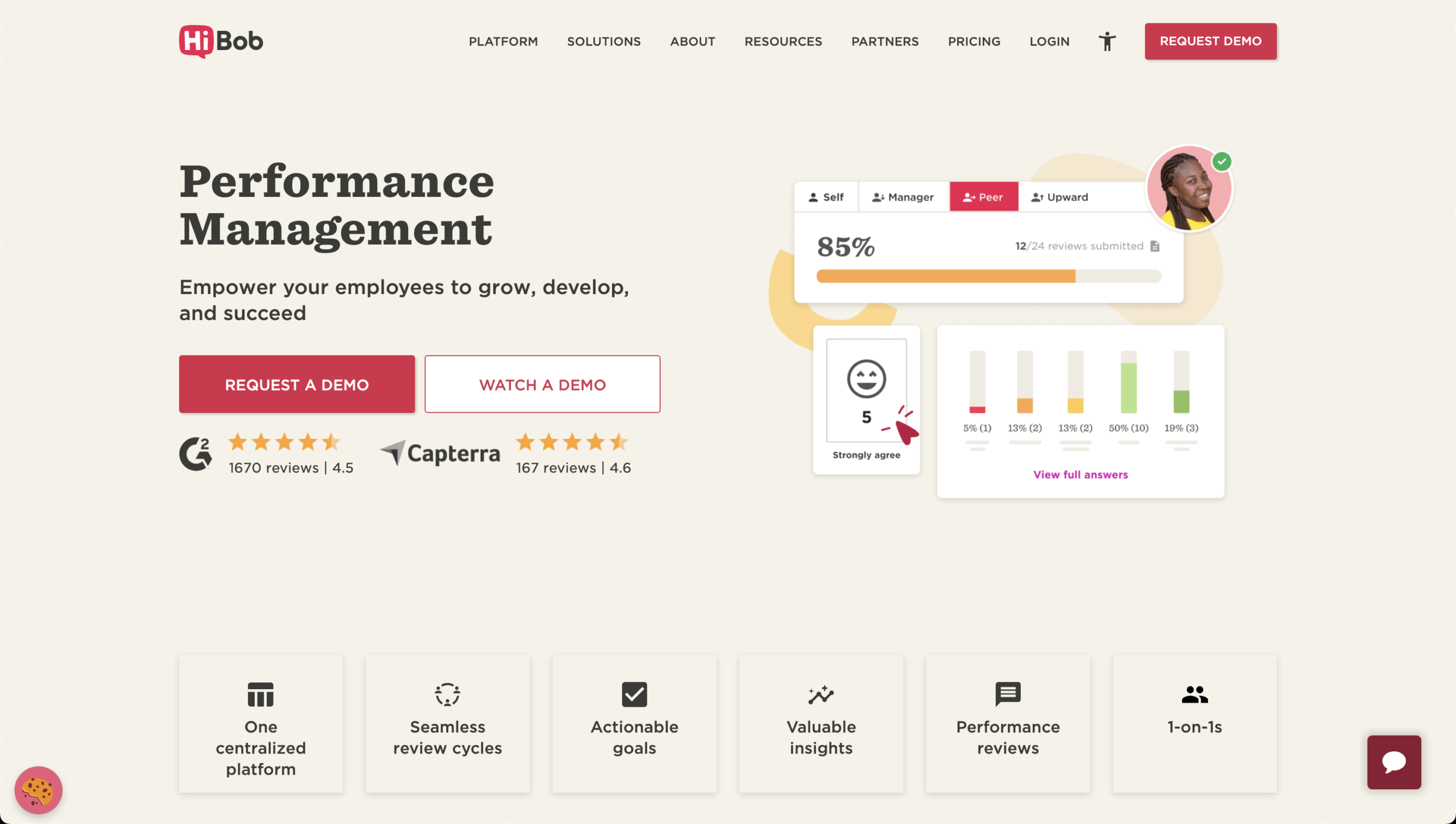
Best for: Global businesses that want to streamline HR tasks and drive better employment decisions. HiBob is a functional HRIS that drives business success by unifying all things HR under one platform.
Pros:
- Streamlines hiring, onboarding, and performance management
Cons:
- Limited customization, learning curve for HR admins
Pricing: Pricing on request. No free trial.
6. ThriveSparrow
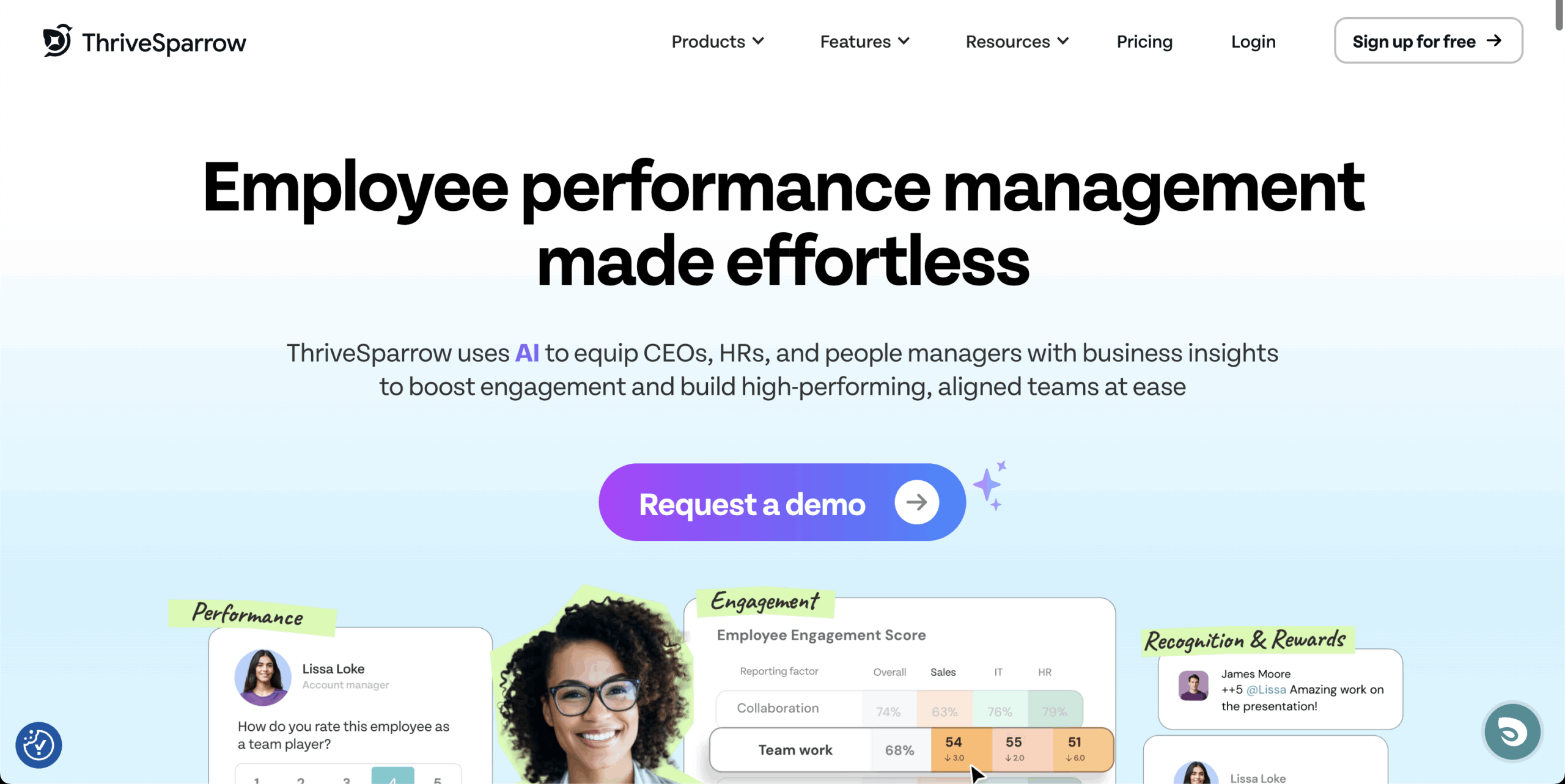
Best for: Small to midsize orgs that want performance insights without enterprise complexity. ThriveSparrow blends customizable reviews, AI-powered growth plans, and performance dashboards. It is intuitive and affordable, though best for companies under a few hundred employees.
ThriveSparrow is a modern performance management platform built to help teams grow, engage, and thrive — all in one place. ThriveSparrow blends continuous feedback, AI-generated personal development plans, 360° reviews, and performance analytics into an intuitive, manager-friendly dashboard.
Pros:
- Customizable performance review templates: run reviews your way with flexible formats, timelines, and visibility settings
- AI-generated personal development plans: turn review data into tailored growth paths—automatically
- Actionable performance dashboards: track strengths, growth areas, and trends across individuals and departments with Infer AI
Cons:
- Basic API, limited integrations
Pricing: From $5 per user per month, 10-user minimum. Free trial available.
7. Trakstar
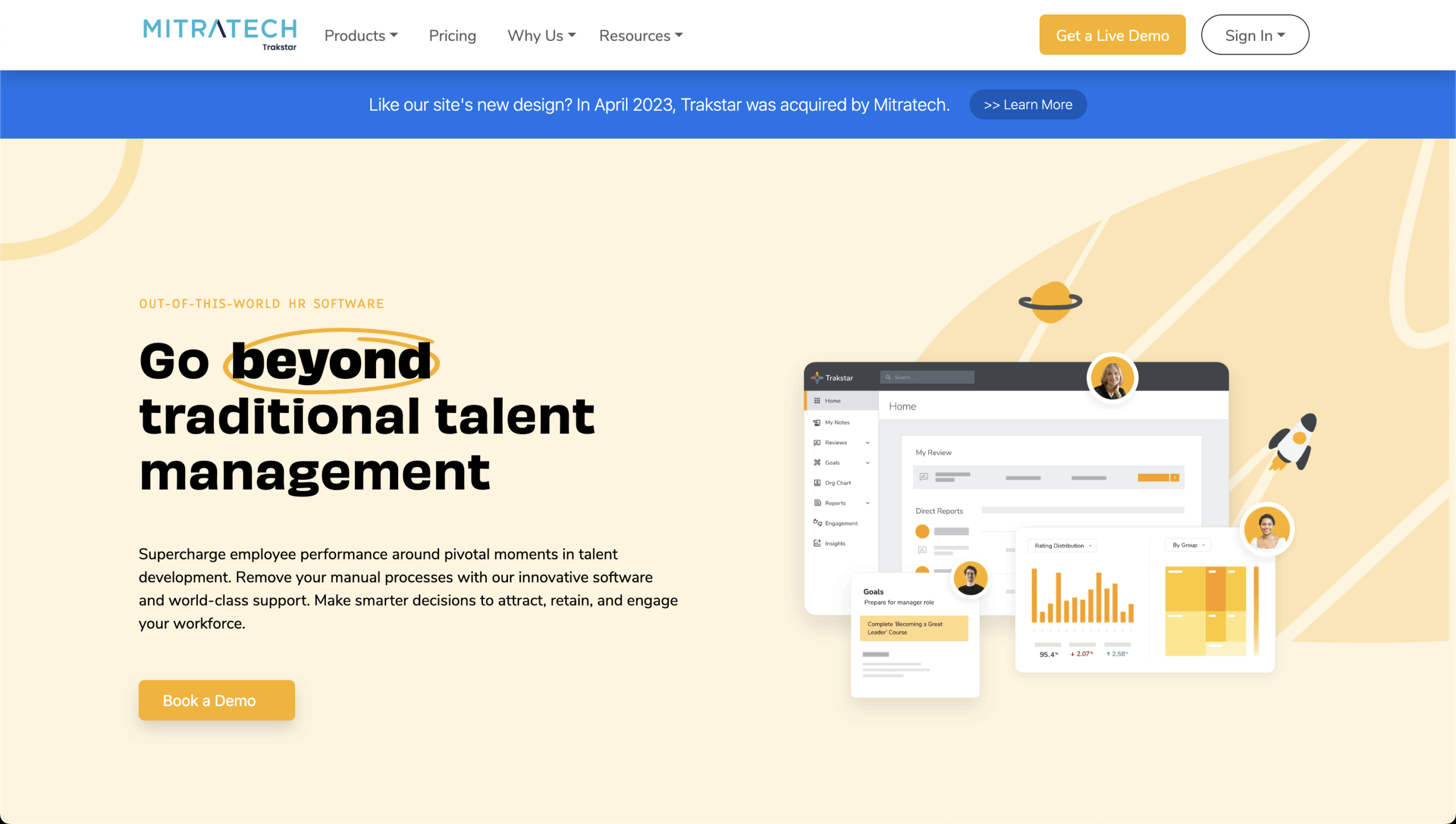
Trakstar Perform offers a flexible performance review platform with custom templates, goal alignment, and multi-rater feedback options. It’s especially useful for companies transitioning from manual reviews to a more structured digital approach, with a strong onboarding experience and friendly support team.
Best for: SMBs and mid-size companies looking for a straightforward review platform with flexible workflows and a user-friendly interface.
Pros:
- Ability to customize
Cons:
- Navigation quirks, less help from support team
Pricing: From $4 per user per month.
8. Joy of Performing (JOP)
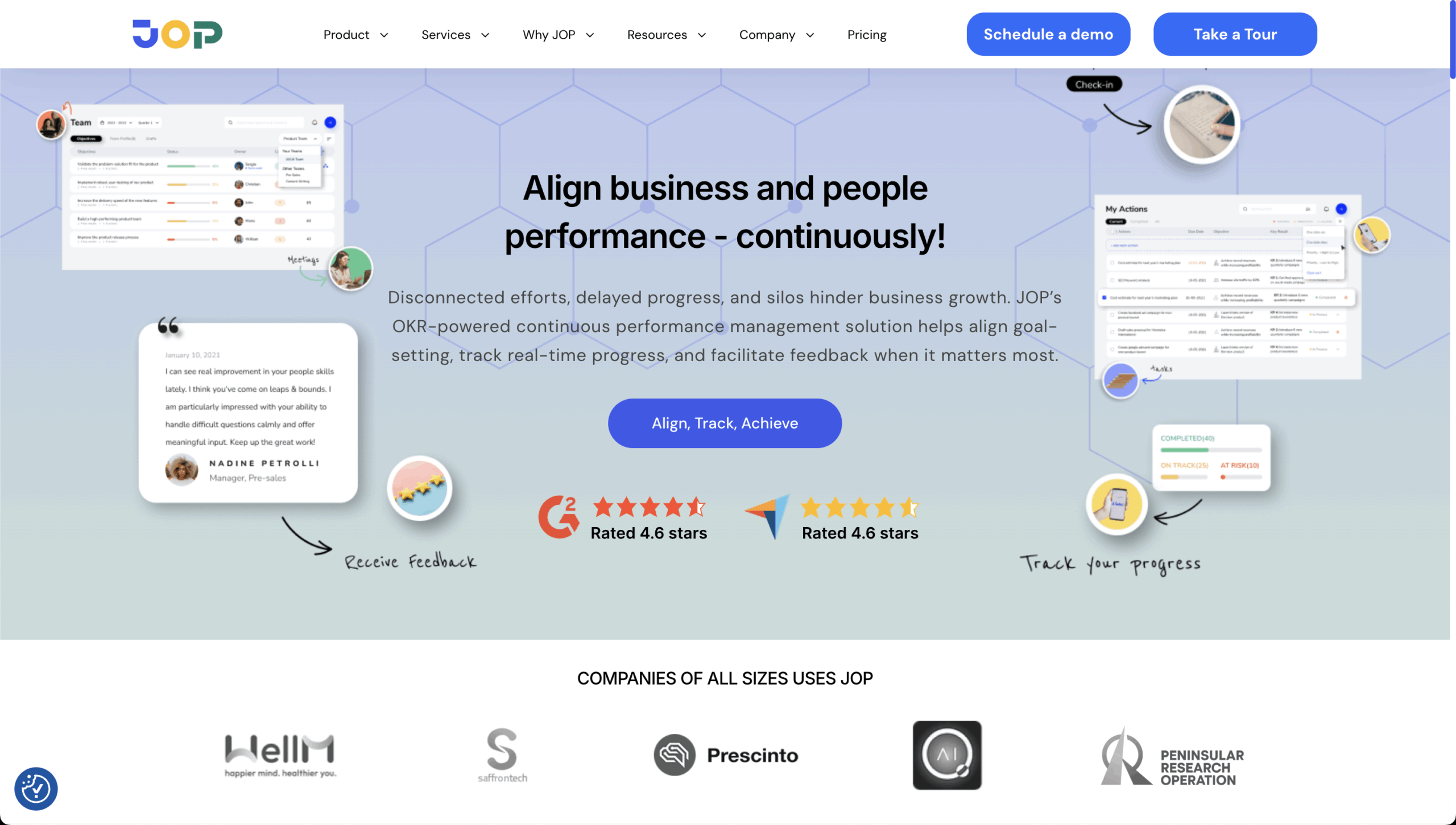
Best for: OKR-driven teams that want structure and skill development in one place.
JOP is an OKR-first platform offering 360s, continuous reviews, and competency-based assessments. It is best for scale-ups that want to tie goals to execution.
Pros:
- OKRs, AI nudges, competency tracking
Cons:
- Limited integrations, clunky mobile experience
Pricing: From $6 per user per month. Free tier for up to 10 users.
9. PeopleGoal
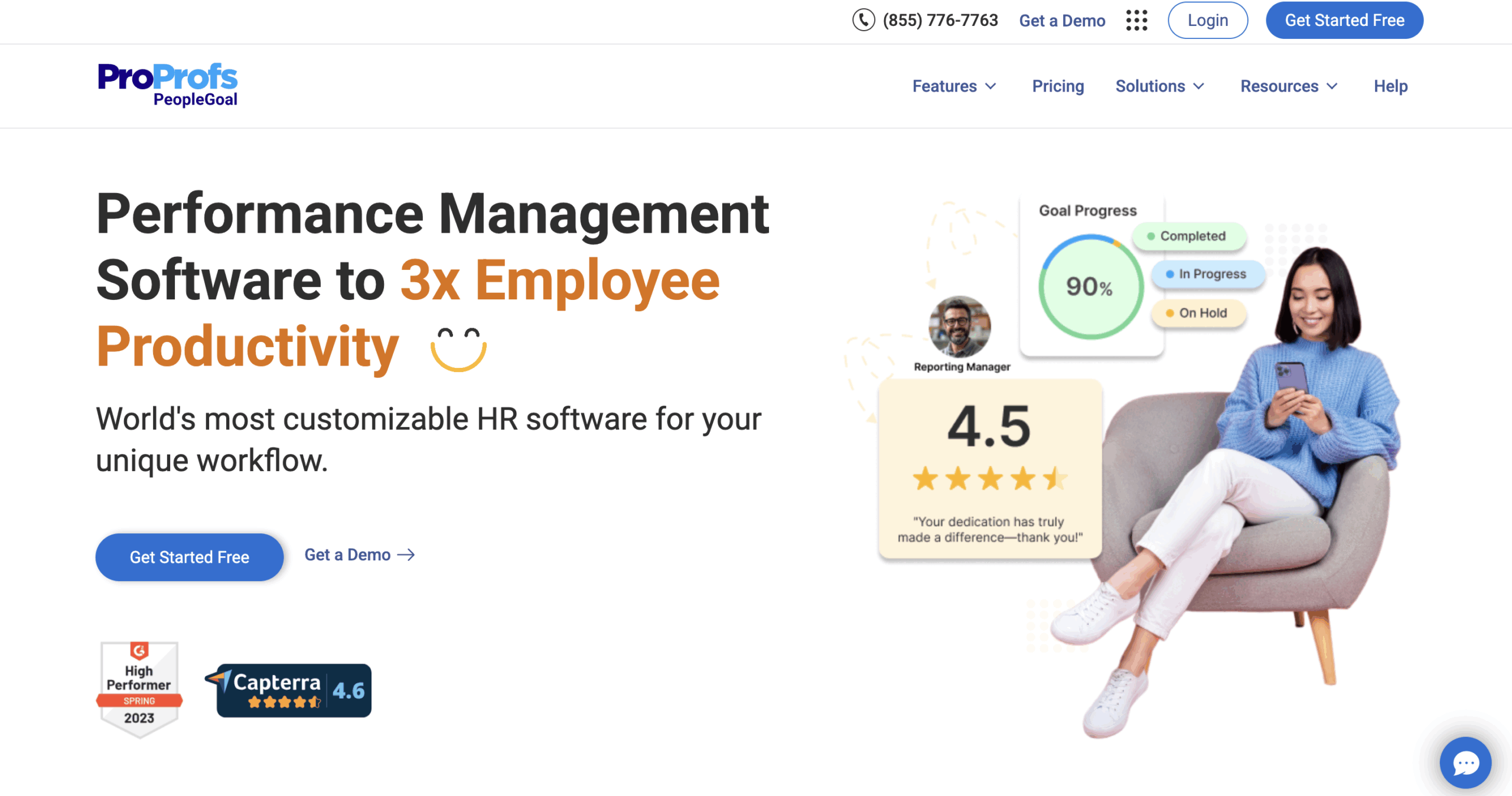
Best for: Global teams that want custom employee performance management, engagement, & HR features.
PeopleGoal is a flexible performance platform that lets you run reviews, set goals, and gather feedback without forcing a fixed process. It supports OKRs, SMART goals, and regular check-ins, with engagement tools like surveys and peer recognition built in.
Pros:
- Custom workflows, OKRs and SMART goals, pulse surveys, eNPS, and recognition.
Cons:
- No dark mode, steeper learning curve for some users.
Pricing:
- From $4 per user per month. Free 7-day trial available.
10. Engagedly
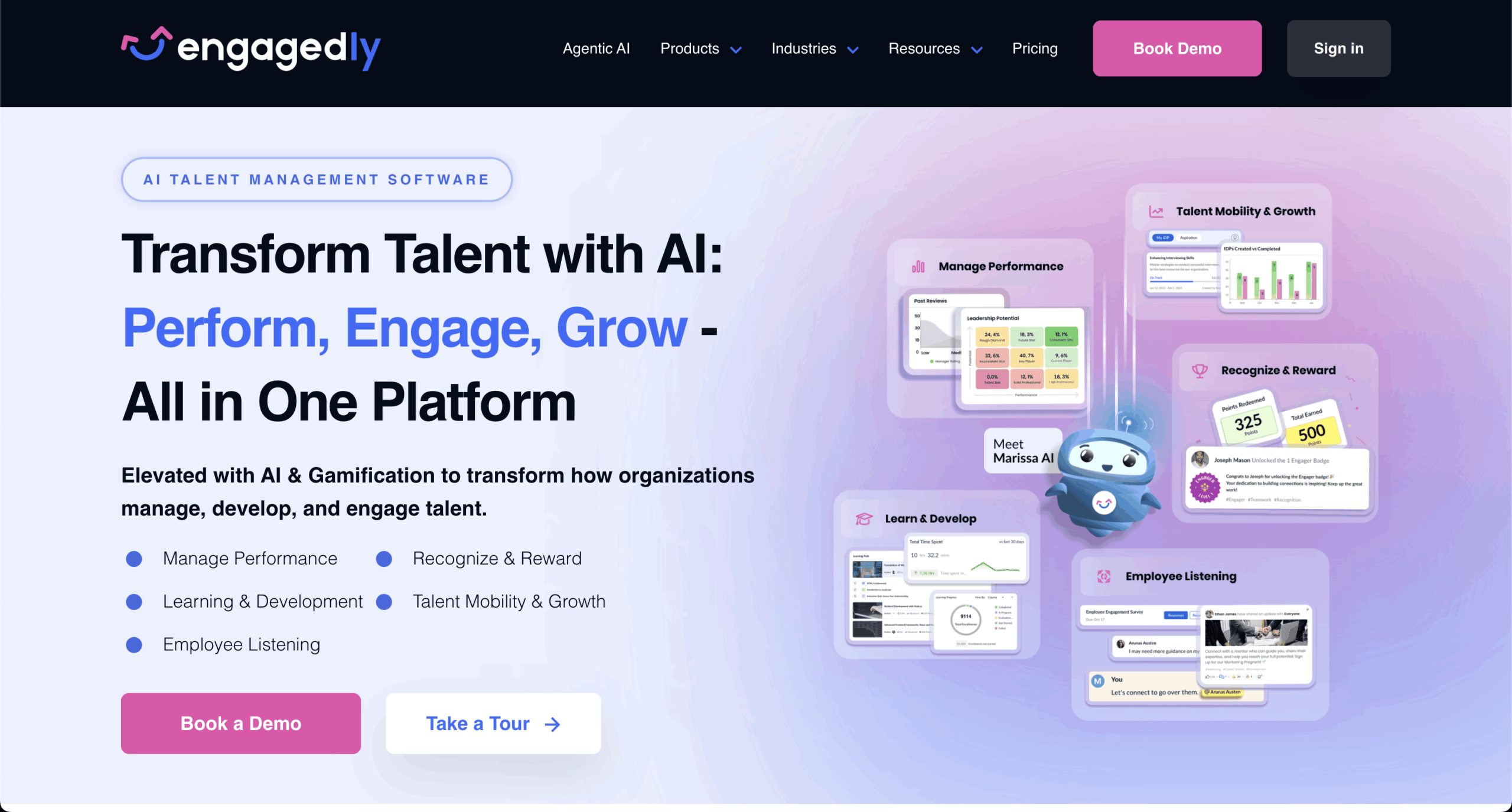
Best for: Forward-thinking companies that want to scale their people strategy with intelligence, not complexity.
Engagedly is an AI-driven talent management platform that helps organizations manage performance, develop talent, and boost engagement—from one intelligent system. By combining performance reviews, OKRs, engagement surveys, learning paths, and social recognition, Engagedly replaces fragmented HR tools. AI copilots power the platform—offering real-time nudges, insights, and automation to help managers make smarter decisions, faster.
Pros:
- Performance & 360° reviews: custom cycles, calibration, 9-box talent grids, and AI-generated feedback summaries, Goals & OKRs: cascaded objectives with live progress check-ins and threaded feedback, Engagement & recognition: pulse surveys, social praise wall, badges, and rewards store, all tied into analytics
Cons:
- Confusing admin navigation, rigid recognition features
Pricing: From $5 per user per month with approximately $7,500 annual minimum. Free trial available.
Final thoughts: Choose what fits your team and culture
Performance tools should make it easier to have the right conversations at the right time. They should help teams grow, not just check a box. Whether you are just starting out or scaling fast, the right platform will support your managers, engage your people, and give you the clarity you need to lead.
If you are looking for something simple, flexible, and people-first, Small Improvements might be the right fit. And if not, that is totally fine. Hopefully, this guide helped you get one step closer to finding what will.



